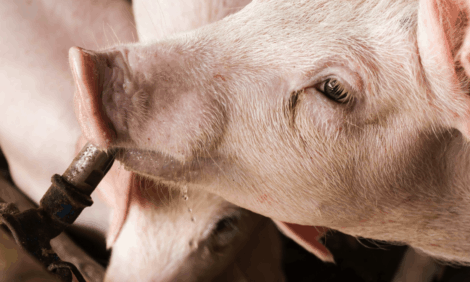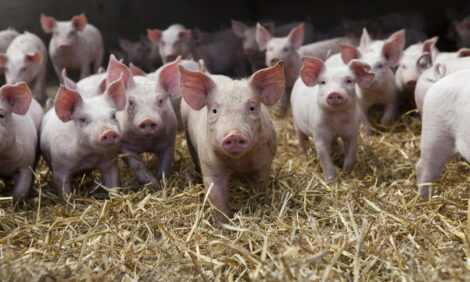



February 2002: Review of the U.S Hog Market
Our Monthly look at the trends in US Hog Market and what effect thes may have on future prices; Strong Hog Prices In Early 2002; Strong Pork Exports Boost Prices; Retail Pork Demand Holds Steady In 2001; Outlook; Futures Based Cash Price Forecasts - Written by James Mintert, Kansas State University.Strong Hog Prices In Early 2002
Barrow and gilt prices were well above last year during January and early February. Through the first week of February, Iowa-S. Minnesota barrow and gilt prices averaged $55 per cwt. (carcass weight), up about 5% compared to a year ago. The increase occurred despite the fact that average wholesale pork values during the same time were virtually unchanged from 2001. The price strength was particularly impressive in light of the fact that weekly hog slaughter averaged 1.845 million head, down just 0.3% compared to last year. And pork production was larger than last year because U.S. producers continue to market hogs at heavier weights. Pork production averaged about 1% above last year's levels during the first six weeks of the year.Strong Pork Exports Boost Prices
Pork exports were very strong during 2001's fourth quarter. During October and November (December data has not been released yet), total U.S. pork exports rose 17% above the previous year. The bulk of the pork export increase was attributable to an increase in pork exports to Japan (the largest U.S. pork customer) as October-November exports to Japan rose 43% compared to 2000. Apparently concerns about BSE among Japanese stimulated demand for beef substitutes and U.S. pork was a big beneficiary. The pork export gains have been particularly impressive because they took place while the Japanese still have the "Safeguard" tariff in place. Some of this year's price strength could be attributable to strong pork export demand. |
Retail Pork Demand Holds Steady In 2001
Final per capita consumption data are not yet available for 2001, but preliminary data indicates per capita pork consumption in the U.S. fell from 52.4 to 51.8 pounds, a decline of about 1.2%. The small decline in pork supplies helped push inflation adjusted retail pork prices up about 1.5% to 2%, depending on the inflation measure that is used. So, pork demand index calculations, which essentially compare actual inflation adjusted pork prices with prices expected if demand was held constant at a prior year's level, indicate that retail pork demand ranged from unchanged to down less than 1% compared to 2000's. Final adjustments in pork imports and exports for December could alter the 2001 demand index calculations slightly. Overall, demand index calculations indicate pork demand has been relatively stable the last three years, and substantially stronger than in the mid-1990's. |
Outlook
Winter quarter hog slaughter was forecast to fall about 1% below a year ago, following the December Hogs and Pigs report. Slaughter during the first half of the quarter was 0.3% smaller than last year, albeit with a lot of weekly variation. Slaughter the rest of the quarter should be equal to or slightly below a year ago. Weights will remain heavy which will keep pork production above a year ago. Slaughter this spring is also expected to wind up near a year ago, but heavy weights will again keep pork production above spring 2001's.Wholesale pork price strength started to wane in February. Belly prices were near $70 in early February, but dipped to $67 by mid-month. Similarly, ham values dipped from about $52 to $46.74. Weakness in wholesale prices in turn drove barrow and gilt prices lower. Iowa-S. Minnesota barrow and gilt prices averaged $56.72 per cwt. (carcass weight) during the first week of February, but declined about $2 per cwt. by February 12th.
Seasonally, barrow and gilt prices tend to strengthen from mid-winter through the spring. And barrow and gilt prices in early 2002 were higher than expected. So, the winter quarter barrow and gilt price average could wind up in the upper $50's, instead of the mid-$50's forecast following the December Hogs and Pigs report. Spring quarter prices are still expected to average in the upper $60's (carcass weight), down from last year's $70.33 average. Larger slaughter next summer is likely to result in summer quarter prices averaging declining into the high $50's to low $60's (carcass weight).
Futures Based Cash Price Forecasts
Futures prices, adjusted for basis expectations, are a source of continuously updated cash price forecasts. As an example, Western Corn Belt 51-52% lean barrow and gilt price forecasts based upon futures prices at the time of this writing (2/13/02) settlement prices) adjusted for basis expectations are included in a graphical format. Basis forecasts are based upon the most recent three-year average basis for 51-52% lean barrows and gilts. To provide some indication of the amount of risk present, forecasts based upon the most positive and negative basis of the last three years are also included. |
Weekly updates (in graphical form) of these price forecasts are also available on the K-State Livestock & Meat Marketing Web Site (www.agecon.ksu.edu/livestock) in the weekly electronic publication entitled Hog Price & Supply Graphs.
Information provided by KSU Livestock report. For more information visit the KSU Livestock website.
Reproduced with permission.








